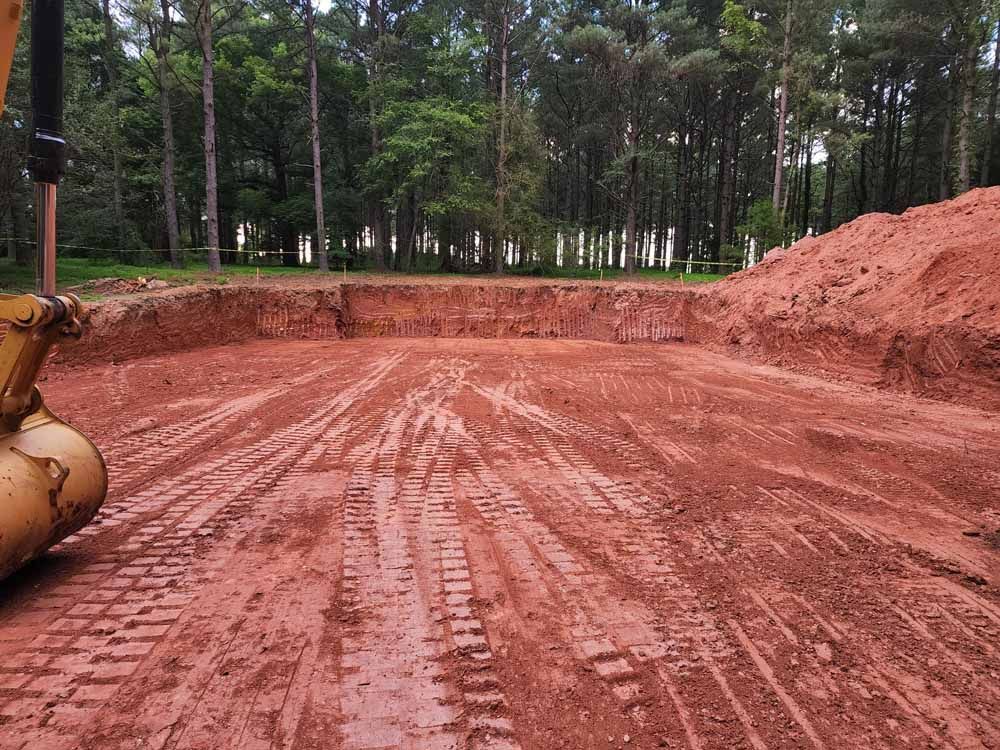Building Pads Wendell, NC
Looking for Top Building Pads Contractor?
At
A1 Grading Inc., we specialize in building pad construction, ensuring a safe and stable foundation for both residential and future buildings in Wendell, NC. Our pad construction process is meticulously planned, taking into account soil composition, drainage, and the specific requirements of the building site. Whether it's a large or small project, our team uses heavy equipment and precision techniques to ensure the pad is constructed correctly, providing a solid foundation that can support heavy loads and withstand varying soil stability conditions.

Efficient Site Preparation for
Construction
Advanced Equipment:
Utilizing state-of-the-art heavy equipment ensures quick and precise site clearing.
Experienced Team:
Our seasoned professionals at A1 Grading Inc. understand the nuances of the land, ensuring swift decision-making.
Pre-Planning:
Detailed assessments and planning ahead of time minimize unexpected delays.
Soil Analysis:
Understanding soil composition allows for targeted and efficient groundwork.
Streamlined Processes:
Years of experience have led to optimized workflows, reducing preparation time.
Eco-friendly Techniques:
Efficient methods that prioritize environmental concerns ensure minimal wastage and land disruption.
Precision Foundation
Excavation Techniques
Laser-Guided Equipment
At A1 Grading Inc., we employ laser-guided equipment to ensure the utmost precision during the foundation excavation process.
Soil Stability Analysis
Understanding the soil's composition and stability is crucial for a successful foundation excavation.
Tiered Excavation Approach
For sites with varying soil compositions or challenging terrains, we adopt a tiered excavation approach.
Reinforced Shoring Techniques
In areas prone to soil collapse or where the water table is high, we utilize reinforced shoring techniques.
Continuous Monitoring
To maintain the highest standards of precision, our experts at A1 Grading Inc. continuously monitor the excavation site.
Frequently Asked Questions
-
What is the primary purpose of backfilling in construction?
Backfilling in construction primarily ensures a safe and stable foundation for structures. It involves filling the excavated areas around a building pad or foundation with soil or other materials to support the structure and ensure its stability. Proper backfilling is crucial for the construction process, ensuring that the building site is prepared correctly to support future buildings.
-
How does proper backfilling contribute to the stability of a structure?
Proper backfilling contributes to the stability of a structure by ensuring that the soil composition around the foundation is compacted and even, preventing any uneven settling or movement. A well-constructed building pad, combined with meticulous backfilling, ensures that the structure built on it has a solid foundation. This process also helps in evenly holding the weight of the structure, reducing the risk of cracks or damages in the future.
-
What materials are commonly used for backfilling solutions?
Common materials used for backfilling solutions include dirt, sand, gravel, and other engineered fill materials. The choice of material often depends on the soil stability required for the project and the specific needs of the construction site. For instance, a dirt pad might be used for residential homes, while other structures might require a mix of materials to ensure a stable foundation.
-
How does the backfilling process affect drainage around a structure?
The backfilling process plays a pivotal role in drainage around a structure. Properly graded areas ensure that water flows away from the foundation, preventing moisture accumulation and potential water damage. Additionally, the type of soil used in backfilling can absorb or direct water, affecting how much water is retained or drained, ensuring effective drainage and preventing issues like soil erosion or foundation flooding.
-
What are the potential risks of improper backfilling, and how can they be mitigated?
Improper backfilling can lead to several risks, including an unstable foundation, drainage issues, and increased construction costs. For instance, if a house pad isn't constructed correctly, it might not support heavy loads, leading to structural damages. To mitigate these risks, it's essential to ensure that the site preparation is done in a professional manner, using the right equipment and materials. Regular inspections by a house builder or contractor can also help identify and address any potential issues early on, ensuring the longevity and safety of the structure.
Contact Us
Contact Us
We will get back to you as soon as possible
Please try again later
Contact Information
Phone:
(919) 422-0223
Email:
Address:
1201 Martin Pond Rd, Wendell, NC 27591, United States of America


